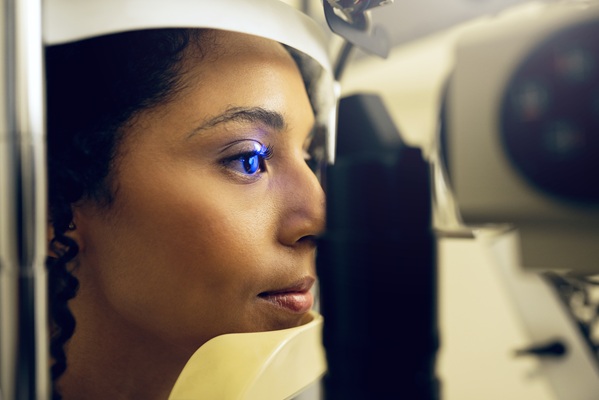Visit Your Eye Doctor for Myopia Control

Myopia is a vision problem that makes words, signs, and objects far away seem blurry. Optometrists offer several types of myopia control to correct this common vision problem. While the most common treatment options are eyeglasses and contacts, other more permanent options exist. Read on to learn about myopia and how an optometrist can treat it in children and adults.
What is myopia?
With myopia, people have no trouble seeing objects nearby but struggle to discern objects in the distance. That is why this condition is also known as nearsightedness. According to the American Optometric Association, or “AOA,” myopia is increasingly common, with one in four parents having a myopic child. However, it is also possible to develop myopia later in life.
Causes of nearsightedness
Like any condition, several factors could cause myopia. Genetics often play a role, but environmental factors could also be to blame. Certain health conditions, such as diabetes, can also lead to myopia. Another common cause is spending a lot of time doing up-close activities, such as reading, working on the computer, and using a smartphone or other handheld devices.
In medical terms, the root cause of myopia is a refractive error. This is when the cornea, lens, or even eyeball shape makes it difficult for light to focus on the back of the eye (the retina). Whichever it is, the refractive error will make any words or objects far away appear blurry.
Diagnosing myopia in children and adults
When myopia develops with age, one can typically tell that their vision is deteriorating, prompting them to visit the optometrist. It can be a little more difficult to diagnose myopia in children, as they likely do not know that everyone else is not having the same trouble seeing or that there is even an available treatment. Fortunately, an optometrist can catch vision problems in children and offer vision correction during an eye exam.
While eye exams are recommended annually, it can be easy to forgo them when the issues are not very noticeable. However, early myopia control can help prevent further eye strain and issues. Do not wait to see an optometrist if one has trouble seeing objects in the distance. Here are other signs of undiagnosed myopia to look out for:
- Eye strain
- Frequent headaches
- Having to squint to see far away
- Needing to hold books and objects close to see them
- Fatigue while driving or watching sports, movies, etc.
Myopia control and treatments
If an optometrist diagnoses a patient with myopia, there are several forms of myopia control to consider. Take a better look at these various vision correction options below.
Prescription glasses or contact lenses
Eyeglasses and contact lenses are the most common types of myopia control, as they are affordable and noninvasive. The optometrist can create a prescription for the patient during their eye exam. Most optometrists will also have a wide selection of eyeglasses, with opticians to help fit each patient. Depending on the office, making prescription eyeglasses may take seven to 14 business days.
Contact lenses can also help correct myopia. If the patient desires this form of myopia control, the optometrist will fit them for contacts at the end of their eye exam. This involves measuring the eye’s surface to ensure a proper fit and checking the eye’s natural lubrication production to ensure it can support the use of contacts. It will take about five to seven business days to make prescription contacts.
Laser eye surgery
Laser eye surgery is a more permanent form of myopia control. With glasses and contacts, prescriptions typically need to be updated annually or every few years; laser eye surgery results can last a lifetime. There are three common types of laser-assisted procedures to consider:
- LASIK: Also known as laser-assisted in situ keratomileusis, LASIK is a procedure in which the eye doctor reshapes one’s inner corneal tissue with a laser to correct myopia.
- LASEK: Laser-assisted subepithelial keratectomy, or LASEK, is a procedure in which the eye doctor reshapes the outer corneal layers to correct myopia.
- PRK: Photorefractive keratectomy is a procedure in which the eye doctor focuses on reshaping and flattening the corneal surface with a laser to correct mild to moderate myopia.
Consult an optometrist for myopia control
Visit an eye doctor if you or your child has trouble seeing objects far away. Whether you are looking for glasses or a more permanent solution like laser eye surgery, we can help. Call our Dallas office to schedule an eye exam.
Request an appointment here: https://www.texasoptical.net or call Texas Optical at (214) 771-7333 for an appointment in our Dallas office.
Check out what others are saying about our services on Yelp: Myopia Control in Dallas, TX.
Recent Posts
For those living with diabetes, undergoing a diabetic eye exam is one of the most important steps in protecting their vision and overall eye health. High blood sugar levels can lead to a range of complications, including conditions that damage the eyes over time. These exams help detect these issues before they become serious, allowing…
Contact lenses provide clear vision and convenience for individuals who prefer an alternative to eyeglasses. However, proper care and maintenance are essential to prevent infections, irritation, and eye damage. Neglecting hygiene practices can lead to serious eye conditions, including corneal ulcers and keratitis. Understanding how to clean, store, and handle contact lenses ensures long-term eye…
Maintaining eye health and preventing long-term issues is the result of consistent and quality vision care. Many people focus on overall wellness but may overlook daily habits that support healthy eyesight. However, taking simple steps each day can protect vision, reduce eye strain, and prevent future complications. By making eye health a priority, it is…
Prescription contacts provide vision correction, comfort, and convenience for those who do not want to wear glasses. However, caring for and wearing contacts takes some getting used to. Learning to insert, remove, and maintain them will help ensure a comfortable and safe experience.Not all contact lenses are the same, and choosing the right pair is…


